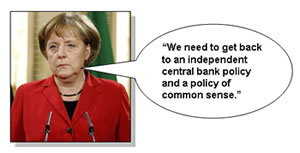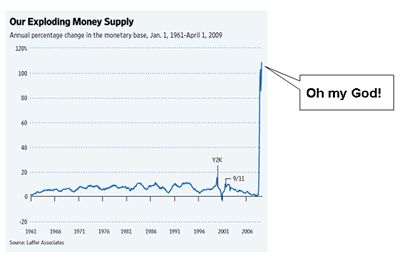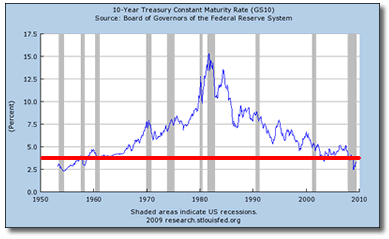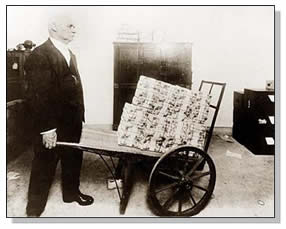
“The cities were still there … but the victims were millions of people. They had lost their fortunes, their savings; they were dazed and inflation-shocked and did not understand how it had happened to them and who the foe was who had defeated them. Yet they had lost their self-assurance, their feeling that they themselves could be the masters of their own lives if only they worked hard enough; and lost, too, were the old values of morals, of ethics, of decency.” –American Journalist Pearl Buck observing the Weimar Republic 1923
Across the nation, brave GonzoBankers are knee deep trying to dig out from non-performing loans and the barrage of regulators. The “asset clean up and capital restoration” fire drill is in full gear, and it’s hard right now for bankers to focus on any issue beyond these near term emergencies.

However … the issue of is one that bankers can ignore at their own peril. Our industry’s laser focus on the credit and capital issues of today cannot allow us to lose sight of the rising enemy that could jolt our world and the assumptions about the future.
In the past few weeks, the debate around the risk of inflation has reached a fever pitch – it’s time for the folks at GonzoBanker to weigh in and give our spin on what this means. The cast of characters parading through this recent debate have been truly amazing. Let me give you a quick play by play. 
The hubbub seemed to start when Nobel economist Paul Krugman started acting like a real weenie with a New York Times op-ed piece, “The Big Inflation Scare,” on May 29. In this technocratic report straight from La-La Land, Krugman concludes:
“It’s important to realize that there’s no hint of inflationary pressures in the economy right now. Consumer prices are lower now than they were a year ago, and wage increases have stalled in the face of high unemployment. Deflation, not inflation, is the clear and present danger… … Yes, we have a long-run budget problem, and we need to start laying the groundwork for a long-run solution. But when it comes to inflation, the only thing we have to fear is inflation fear itself.”
For many bright minds, this “all is well” attempt by Krugman seemed political in nature and akin to whistling past the graveyard. One of the key variables in the inflation debate centers around the unprecedented moves the Federal Reserve has made to pump liquidity into the economy by creating a fat, bloated, obese, cellulite-infested balance sheet in the past 12 months. The following graph should haunt GonzoBankers and U.S. citizens every day until the figures return to normal – it’s a swing for the bleachers from our leaders that could impact generations of Americans:

That’s right. To ward off a global depression, the Fed’s balance sheet has gone from roughly $800 billion to over $2.5 trillion in less than a year. In addition, since shoring up the merger of Bear Sterns with JP Morgan Chase, the risk appetite in the Fed’s balance sheet has grown exponentially. Carnegie Mellon professor Allan Meltzer sums it up best: “Under Mr. Bernanke, the Fed has sacrificed its independence and become the monetary arm of the Treasury.”
There is a growing fear that central bankers of the world have lost their monetary backbone in the name of stemming panic and bringing grease back into the engine of the economy. Many ponder, “Is this what that tough codger Paul Volcker would do at the helm of the Fed?”
Across the globe, world leaders (and bond investors) are questioning the long-term value of U.S. debt. German Chancellor Angela Merkel hit things pretty hard during Obama’s recent European visit:

Many experts who fear inflation have pointed out that commodity prices are the true “canary in the coal mine” for inflation – slow economic growth and tame CPI measures should not calm our nerves. This simple chart of gold prices over the past 10 years hardly looks deflationary. The fact that crude oil has jumped 50% in the past 30 days and 10-year bond rates have hit 4% this week from a low of 2% in December 2008 also illustrates the inflationary momentum building even though we are stuck with a weak economy and high unemployment.

A groundswell in the inflation debate occurred this week when famed and controversial economist Arthur Laffer took a shot in the Wall Street Journal with his “Get Ready for Inflation and Higher Interest Rates” op-ed. Like the Federal Reserve balance sheet, the chart below should haunt us as it blatantly shows us the unprecedented growth in money supply that has been orchestrated over the past year. Decades of 5% – 10% growth levels and suddenly growth of more of than 100%!

Bottom line: this unprecedented growth in the money supply has astute investors now making large bets on the rise of inflation. Hedge fund legend Julian Robertson has postulated that long rates could hit 7% easily and could go as high as 18%.  Here’s a recent statement from Julian to ponder:
Here’s a recent statement from Julian to ponder:
“I ask anyone to give me an example of an economy beefed up by huge amounts of quantitative easing that did not inflate tremendously when or if the economy improved. I think what we’re doing now will either fail, or it will result in unbelievably high inflation – and tragically, maybe both.”
So there you have it, GonzoBankers. Let’s keep working those bad loans, managing expenses and restoring capital. At the same time, let’s remember some key steps to take as a financial institution that could face a much different rate environment:
1) Put the ALCO process on steroids – the information, discussion and debates regarding the structure of your bank’s balance sheet, risk appetite and pricing strategies for your core business have never been more important. There is more money to be made from an astute ALCO process in the next several years than any new product or line of business could possibly produce.
2) Get serious about “shock” levels – with short rates near zero and long rates at 4%, the standard “up 300/down 300” scenario playing just doesn’t cut it. Many banks are shocking more in the up 400 – 500 range to get a grip on capital and margin at risk.
3) Watch the medium-term fixed rate loans and investments – there’s been some recent steepening and some fairly nice “carry trade” opportunities for banks, but with this pressure building, it’s not a time to get greedy. Check out the chart below, which illustrates the past 50 years of 10-year Treasury rates, and realize that everything above the red line is a time when long rates have been higher than today – i.e. the vast majority of the time.

4) Look to hedge with funding – while the mad rush for non-interest bearing deposits would be a nice gift in a rising rate environment, growth in this one line item will be difficult. Instead, banks will have to war game how they position their money market product and look to medium term CDs and borrowings to reduce the risk of a too extreme jump in funding costs. This is no easy task, but it needs to be an active topic in ALCO discussions.
5) Keep “the man” honest – at this juncture in the economy and the industry, bankers too must have a strong voice in encouraging a Fed that lives and dies on providing sound money. As economist Milton Friedman once concluded,“Inflation is the one form of taxation that can be imposed without legislation.” The purpose of this column is not to be alarmist, but too often our leaders miss the obvious in their highly-parsed intellectual drivel and end up creating serious pain for average folks. It may be extreme for investors and industry observers to use  Weimar Republic metaphors for our explosive growth of loose money, but it’s always important to keep this reality in perspective. Germany in 1923 was a time when folks actually used wheel barrels to move cash. It’s surreal to remember what the terror of hyperinflation must have felt like when reading this account of Weimar Germany:
Weimar Republic metaphors for our explosive growth of loose money, but it’s always important to keep this reality in perspective. Germany in 1923 was a time when folks actually used wheel barrels to move cash. It’s surreal to remember what the terror of hyperinflation must have felt like when reading this account of Weimar Germany:
When the 1,000-billion Mark note came out, few bothered to collect the change when they spent it. By November 1923, with one dollar equal to one trillion Marks, the breakdown was complete. The currency had lost meaning.
Here’s to hoping and praying that we will see disciplined control of the money supply and Fed balance sheet and a fierce return to fiscal discipline in our country. In the meantime, GonzoBankers, it’s best to prepare for a potentially roaring ride up the yield curve.
-sw
-Efficiency Improvement
-Strategic Planning
-Technology Assessment
-Technology Planning
-Risk Management
-Merger Integration
-Vendor Selection
-Conversion Management